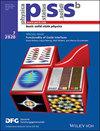铬合金化对铁铬合金中面心立方到体心立方相变的启示
IF 1.8
4区 物理与天体物理
Q3 PHYSICS, CONDENSED MATTER
引用次数: 0
摘要
通过第一原理计算,研究了铬合金化对体心立方(bcc)和面心立方(fcc)相的相稳定性、磁性和电子结构的影响,以及对从 fcc 到 bcc 转变的影响。结果表明,在 fcc 和 bcc 相中,掺杂的铬原子选择了不同的占据模式。这一现象可以从接近费米能的电子密度状态量中得到理解。就磁性而言,在所研究的相中,铬倾向于与周围的铁发生反铁磁耦合。在 bcc 中,铁的磁矩大于铬的磁矩,但在 fcc 中,两者的顺序正好相反。 在 bcc 中,铁的磁矩由它与掺杂的铬之间的距离决定,而在 fcc 中,它则受与铬的空间取向的支配。 在相稳定性方面,研究发现,铬的合金化倾向于破坏 bcc 的稳定性,而倾向于稳定 fcc,从而强烈抑制了从 fcc 到 bcc 的相变。值得注意的是,在 fcc 相中的作用比在 bcc 中的作用更为突出,这可能与 fcc 中铁和铬之间的反铁磁性有关。本文章由计算机程序翻译,如有差异,请以英文原文为准。
Insight into Cr Alloying on Face‐Centered Cubic to Body‐Centered Cubic Phase Transition in FeCr Alloy
Effects of Cr alloying on phase stability, magnetism, and electronic structures in both body‐centered cubic (bcc) and face‐centered cubic (fcc) phases and on the transformation from fcc to bcc are studied by first‐principles calculations. Results show that the doped Cr atoms in fcc and bcc phases choose distinct occupation models. This phenomenon can be understood from the amount of electron density of states close to Fermi energy. For magnetism, Cr tends to be antiferromagnetically coupled with the surrounding Fe in the studied phases. The magnetic moment of Fe is greater than that of Cr in bcc, but the order is reversed in fcc. The moment of Fe is dictated by the distance between it and the doped Cr in bcc, whereas it is dominated by spatial orientation with Cr in fcc. For phase stability, it is found that the alloying of Cr prefers destabilizing bcc while tends to stabilize fcc, leading to a strong inhibition of phase transition from fcc to bcc. Notably, the role in the fcc phase is more prominent than that in bcc, which can be associated with the antiferromagnetism between Fe and Cr in fcc.
求助全文
通过发布文献求助,成功后即可免费获取论文全文。
去求助
来源期刊
CiteScore
3.30
自引率
6.20%
发文量
321
审稿时长
2 months
期刊介绍:
physica status solidi is devoted to the thorough peer review and the rapid publication of new and important results in all fields of solid state and materials physics, from basic science to applications and devices. Being among the largest and most important international publications, the pss journals publish review articles, letters and original work as well as special issues and conference contributions.
physica status solidi b – basic solid state physics is devoted to topics such as theoretical and experimental investigations of the atomistic and electronic structure of solids in general, phase transitions, electronic and optical properties of low-dimensional, nano-scale, strongly correlated, or disordered systems, superconductivity, magnetism, ferroelectricity etc.

 求助内容:
求助内容: 应助结果提醒方式:
应助结果提醒方式:


